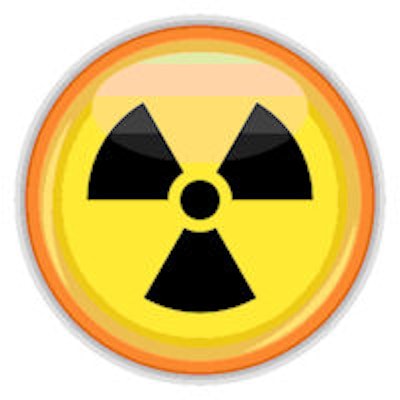
How low can low-dose CT (LDCT) lung cancer screening go? Swiss researchers have tested a new protocol for LDCT screening that reduces radiation dose to nearly the level of a chest x-ray -- a reduction that should lower the risk of a patient developing cancer from the scans in the future.
In a new study published May 20 in PLOS One, a team led by Dr. Natalia Saltybaeva, a medical physicist from University Hospital Zurich, described its use of a low-dose CT scanning protocol in a population of 47 adult patients. The protocol combines a model-based iterative reconstruction technique with a tin filter to shape the x-ray beam. The combination leads to chest CT scans delivering just 0.3 mGy of radiation -- slightly higher than the 0.1 mGy of a chest x-ray.
The researchers found that performing screening at the lower dose levels could dramatically lower the risk that individuals participating in lung screening programs might someday develop cancer from the CT studies, especially if they receive multiple scans over a number of years.
Cancer down the road
CT lung cancer screening has been proved to reduce cancer mortality, but radiation from CT scans could itself cause cancer down the road -- a particular problem as most screening protocols call for subjects to receive multiple scans over the years. Therefore, researchers have sought to reduce radiation dose levels for CT screening as much as possible -- to much lower than the 7 mSv to 8 mSv typically used for CT exams being employed for diagnostic use.
Low-dose CT screening scans typically deliver 1 mSv to 1.5 mSv of radiation, the levels achieved in the landmark National Lung Screening Trial (NLST). Even at such low levels, however, radiation exposure can add up over time: In a 2014 paper in Chest, McCunney et al estimated that performing CT lung screening scans at a radiation dose of 2 mSv would result in an average 55-year-old getting up to 280 mSv of radiation over a 20-year period.
Fortunately, CT vendors have been developing scanning protocols that can reduce radiation dose dramatically, and these protocols are a perfect fit for lung cancer screening. Many of these protocols use iterative reconstruction techniques rather than conventional filtered back projection.
In their PLOS One paper, Saltybaeva et al tested model-based iterative reconstruction with a tin photon shield that eliminates lower-energy photons from the x-ray spectrum, a technique called spectral shaping. The researchers then calculated how the reduction in radiation dose might reduce the cancer risk in a typical screening population of individuals ages 55 to 74 years.
For the patient population, they used 47 individuals -- 27 men and 20 women -- referred to their hospital for unenhanced chest CT scans. Mean patient age was 63 years. In all, 24 patients received a standard-dose CT protocol, while 23 received an LDCT protocol.
All patients were scanned on a 192-slice dual-source CT scanner (Somatom Force, Siemens Healthineers), operating in single-source mode. The standard-dose patients were scanned with attenuation-based tube voltage selection and attenuation-based tube current modulation, with quality reference values of 120 kVp and 70 mAs.
Meanwhile, the LDCT protocol involved CT settings of 100 kVp and 45 mAs, and a 0.6-mm tin filter was used for spectral shaping to eliminate low-energy photons from the x-ray beam. Data were reconstructed using a commercial protocol, advanced modeled iterative reconstruction (ADMIRE, Siemens), at a strength level of 3.
The researchers had a radiologist assess image quality for both sets of acquisitions, and they calculated radiation dose to the lungs using Monte Carlo simulations that took patient parameters into account. They then estimated the potential for radiation-induced lung cancer using a model proposed in the Biological Effects of Ionizing Radiation (BEIR) VII report.
Mean lung dose and cancer risk from the different protocols are shown in the following table. Individuals receiving the LDCT protocol had a sharply lower risk of lung cancer, especially if they received as many as 25 CT screening exams over the course of their lives.
| Mean lung radiation dose and estimated lung cancer risk | |||
| Protocol | Lung radiation dose | Cancer risk in cases per 100,000 for single CT exam | Cancer risk in cases per 100,000 for 25 CT screening exams |
| Standard dose | 7.75 mGy | 8.65 | 215 |
| Low dose | 0.30 mGy | 0.35 | 8.7 |
In addition, patient diameter had a major effect on the radiation dose used, with a strong linear dependency between lung dose and patient diameter with both standard-dose and low-dose protocols. The risk of cancer also dropped for patients older than 60.
The researchers acknowledged that while the lifetime attributable risk of lung cancer from just one low-dose CT exam was low, this could increase due to the need for repeated CT screening exams -- a number ranging from three exams up to 25.
"Our study determined patient- and examination-specific lung dose values, allowing for patient risk assessments, which is mandatory when balancing the benefits and risks from ionizing radiation in the context of lung cancer screening with CT," they concluded. "The lung doses calculated in this study further enhance the need for employing LDCT protocols to lung screening studies for keeping the risk to the general population as low as reasonably possible."



















